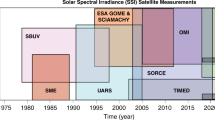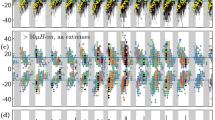Abstract
IT is generally recognized that a solar anisotropy in the primary cosmic radiation must be responsible for at least part of the observed terrestrial daily variation of intensity, although it seems that the exact nature of this contribution is not yet clear. However, Rao, McCracken and Venkatesan1 have recently presented a method of determining the characteristics of a daily variation of this type. Their method takes into consideration the influence of the Earth's magnetic field and in particular they emphasize the part played by the asymptotic cones of acceptance of cosmic ray detectors. Consequently, using experimental values of the daily variation of neutron intensity averaged over the year 1958, they have been able to postulate a type of anisotropy which appears to account for the complex manner in which the amplitude and phase of the first harmonic of the daily variation depends on the geographical location of the detector. However, it would perhaps be truer to say that they predict that if the Earth's atmosphere and its magnetic field were removed the annual mean diurnal variation of intensity observed at the Earth's surface would have the following characteristics : (1) the diurnal variation would be independent of rigidity in the range 1–200 GV; (2) the amplitude would vary as the cosine of geographic latitude and the time of maximum would be in the direction 85° to the east of the Earth–Sun line; (3) the maximum amplitude, observed with narrow-angle detectors at the equator, would be 0.4 per cent of the average primary flux. It is proposed to describe here the co-ordinate transformations which relate these important characteristics to those of a selar anisotropy specified in the frame of reference in which its orientation is fixed.
This is a preview of subscription content, access via your institution
Access options
Subscribe to this journal
Receive 51 print issues and online access
$199.00 per year
only $3.90 per issue
Buy this article
- Purchase on Springer Link
- Instant access to full article PDF
Prices may be subject to local taxes which are calculated during checkout
Similar content being viewed by others
References
Rao, U. R., McCracken, K. G., and Venkatesan, D., J. Geophys. Res., 68, 345 (1963).
Davis, L., Phys. Rev., 96, 743 (1954).
Author information
Authors and Affiliations
Rights and permissions
About this article
Cite this article
JACKLYN, R. A Solar Anisotropy in Cosmic Radiation, viewed from a Terrestrial Frame of Reference. Nature 200, 1306–1307 (1963). https://doi.org/10.1038/2001306b0
Issue Date:
DOI: https://doi.org/10.1038/2001306b0
Comments
By submitting a comment you agree to abide by our Terms and Community Guidelines. If you find something abusive or that does not comply with our terms or guidelines please flag it as inappropriate.



